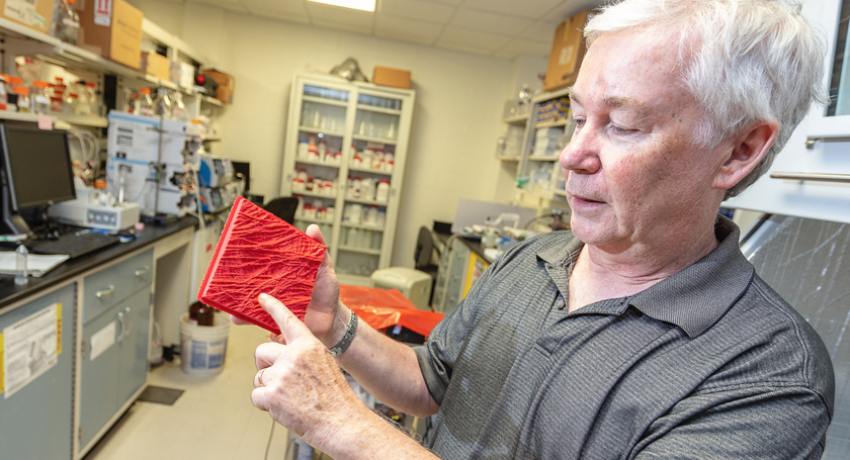Daniel Cosgrove, Professor and Holder of the Eberly Chair in Biology and director of the Center for Lignocellulose Structure and Formation, holds a 3D-printed model of a plant cell wall. Image: Nate Follmer, Penn State
The Center for Lignocellulose Structure and Formation (CLSF), an Energy Frontiers Research Center (EFRC) established by the U.S. Department of Energy (DOE) in 2009 and led by Penn State scientists, has once again had its funding renewed by the DOE for an additional four years. The DOE established ERFCs to accelerate fundamental research and scientific breakthroughs in energy-relevant areas to meet critical energy challenges of the 21st century. The CLSF, which is receiving its third round of funding, was one of only nine centers nationwide recommended for a four-year renewal.
U.S. Secretary of Energy Rick Perry announced $100 million in funding for 42 Energy Frontier Research Centers (EFRCs) to accelerate the scientific breakthroughs needed to strengthen U.S. economic leadership and energy security.
“America’s continued energy security and global competitiveness will depend vitally on a sustained effort in science and discovery,” said Perry. “By mobilizing the talents of our nation’s top scientists and forging them into powerful, pro-active teams, the EFRC program will help ensure America’s leadership in the development of critical energy technologies and innovations.”
The CLSF brings together a diverse group of scientists from eight partner institutions with the shared mission of dramatically increasing our fundamental knowledge of the physical structure and assembly of biopolymers in plant cell walls. Fresh insights and perspectives into the formation and structure of these highly useful, energy-rich, renewable biomaterials could open new frontiers in bioenergy and biomaterials technologies based on cell wall engineering.
“Plants are important sources of renewable energy and carbon-based materials for society’s needs,” said Daniel Cosgrove, Professor and Holder of the Eberly Chair in Biology and director of the Center. “Our center focuses the complementary talents of biologists, physical scientists and engineers to uncover the well-kept secrets of how plants build microscopic threads of cellulose and assemble them with other polymers to make complex structures. These structures — 'cell walls’ — have versatile properties unmatched by current industrial materials. The insights gained in our research could inspire new ways to tailor energy-rich biomaterials and to mimic biological methods to make new kinds of materials.”
The current cohort of EFRCs, selected by competitive peer review, includes 22 new centers and the renewals of nine existing ones. All of the centers will be funded for up to four years. In addition, based on favorable peer review evaluations, another 11 existing centers were awarded two-year extensions to support the completion of valuable research that is still in progress. The four-year centers will receive on average approximately $2 million to $4 million per year.
The knowledge generated by the EFRCs will lay the scientific groundwork for future advances in solar energy, nuclear energy, energy conversion and storage, electronics and computation, production of fuels and chemicals, carbon capture, and control of the earth’s subsurface.
Since 2009, the EFRCs have produced over ten thousand peer-reviewed scientific publications and generated hundreds of inventions at various stages of the patent process, fostering a wide range of new technologies that have benefited multiple private sector companies, both large and small.
Read the full news story here:
https://news.psu.edu/story/529389/2018/07/27/research/center-lignocellulose-s...

